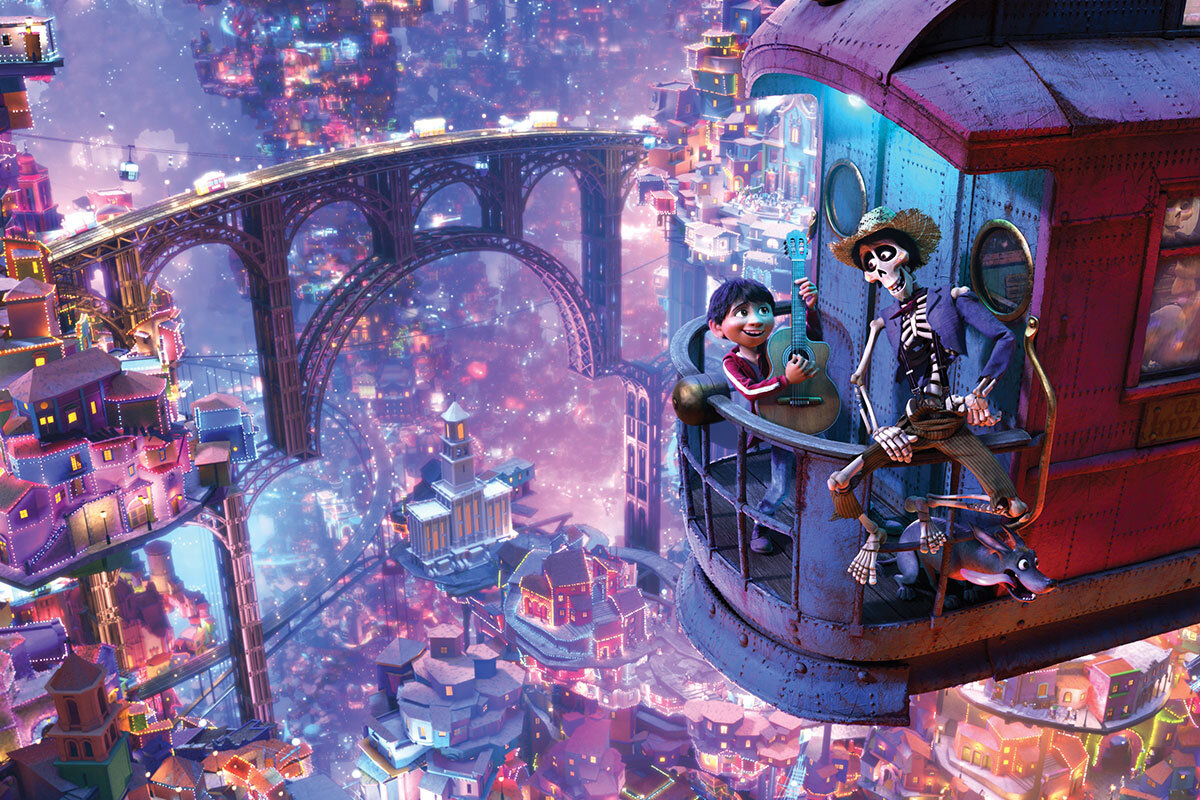Erika Rojas shows the tell-tale signs of having seen a tear jerker when she walks out of the movie theater onto bustling Reforma Avenue on a recent afternoon. Bleary-eyed, she clutches a packet of tissues with one hand while dabbing her nose and eyes with the other.
But Ms. Rojas isn’t sad, she says. “I’m just proud. It was so beautiful. Mexico deserves this.”
Nearly a month after its release in Mexico, the new Pixar film “Coco,” out Nov. 22 in the United States, is already the country’s top-grossing animated film in history.
At a time when the US is casting a bright spotlight on Mexico and Mexican-Americans, frequently stereotyping them as everything from drug-runners to overall “bad hombres,” Coco is an animated salve of sorts. It’s a story many hope can shift impressions of Mexico away from the bad and toward the bountiful good.
The story dives deep into one of Mexico’s most cherished celebrations, Day of the Dead, and focuses on universal themes like family and memory, enveloping them in Mexican music, culture, and art.
“It was a very different time when we started making the film [six years ago], but I’m actually … much happier to bring this film into the world now,” says co-director and Academy-Award winner Lee Unkrich. It puts the “positive beauty of Mexico, Mexican culture, and Mexican people” front and center, he says.
In Coco, Miguel, a young boy who dreams of becoming a musician but is thwarted by his extended family, finds himself accidentally traveling into the world of the dead, from which he refuses to return unless he can pursue his love for music. He crosses a bridge of bright marigold petals with his trusty (and dopy) sidekick, a Xoloitzcuintle hairless Mexican dog. They walk against the traffic as hordes of skeletons move toward the land of the living on their way to celebrate with their families, who have set up ofrendas, or altars, honoring their memories and lives with photos, flowers, candles, favorite foods and drinks, and papel picado, cut-paper flags: all for Día de los Muertos, or “Day of the Dead.”
The film’s attention to detail is part of what has made Coco such a hit here in Mexico. Characters in the Land of the Dead reference famous Mexican artists and icons, both its Aztec and neoclassical architecture are on full display, and, as one viewer wrote on Twitter, “There wasn’t a single cactus” – or someone napping under it, for that matter – in the movie, a common trope when portraying Mexicans, like Speedy Gonzalez, in cartoons.
Day of the Dead has become increasingly hip in the United States, where it’s common to see people with no ties to Mexico or Latin America dressing up and painting their faces as calaveras, or skeletons, for Halloween. But the rich, complex history behind the symbolism isn’t always understood. It’s something Mr. Unkrich, who co-directed the film with Mexican-American Adrian Molina, owned from the start.
He and his team brought in multiple Mexican and Mexican-American cultural consultants to advise on everything from visual representation to music to the script. They made several research trips to towns in the states of Oaxaca and Michoacán to stay with local families and observe Day of the Dead traditions. The nearly all-Latino cast of voice actors also had a say in the dialogue. Mexican actor Gael García Bernal, who voiced the character Héctor in both the Spanish and English versions, at one point told Unkrich that referring to Miguel as muchacho, a Spanish 101 vocabulary word for “kid,” wasn’t quite working for him – how about the much more familiar Mexican term chamaco? Done.
Disney, which owns Pixar, has had a rough track record when it comes to cultural stereotypes and appropriation. Apart from movies like the 1940s-era "The Three Caballeros," with a gun-slinging Mexican rooster who gives rides on a serape blanket, in 2013 Disney tried to trademark the phrase Día de los Muertos. One Mexican-American cartoonist, Lalo Alcaraz, came out hard against the move, creating Muerto Mouse, a calavera-like, Godzilla-looking version of Mickey Mouse who is “coming to trademark your cultura!” Mr. Alcaraz ended up on the team of consultants for Coco.
“We’ve been getting [Mexico] wrong for so long that it has changed cultural perceptions” in the United States, says Frederick Luis Aldama, who teaches about Latin American culture in literature and film at Ohio State University, referring to the reliance on stereotypes in film and popular culture. “Getting it right really matters,” he says. “There’s a chance that it can humanize your neighbors.”
Despite the film’s success in Mexico, the team was nervous ahead of the US release.
“The notion of culture and heritage in the Mexican-American community is distinct from what Mexicans feel in Mexico,” says Marcela Davison Aviles, another cultural consultant on the film. “The expectations are different on either side of the line,” she says, referring to the US-Mexico border.
One thing Ms. Aviles, Unkrich, and others on the team agree on is how the importance of family shines through in “Coco”: a value that, while shown in a uniquely Mexican context, reaches across borders.
Miguel connects with a handful of his deceased relatives in the Land of the Dead, and starts to grasp the importance of remembering them and talking about them back in the land of the living. Without those seemingly simple actions, like putting up a photo of a dead great-aunt on Day of the Dead, tradition has it, they will cease to exist even in the Land of the Dead, and lose their ability to celebrate with their living loved ones.
Aviles says her hope is that “someone not well acquainted with Mexico will come out [of seeing Coco] with an ‘aha moment’ and say, ‘I had no idea. I had no idea it was the same: That we are all concerned for family, for our place on this planet. We are the same. I’m glad I discovered that.’ ”





